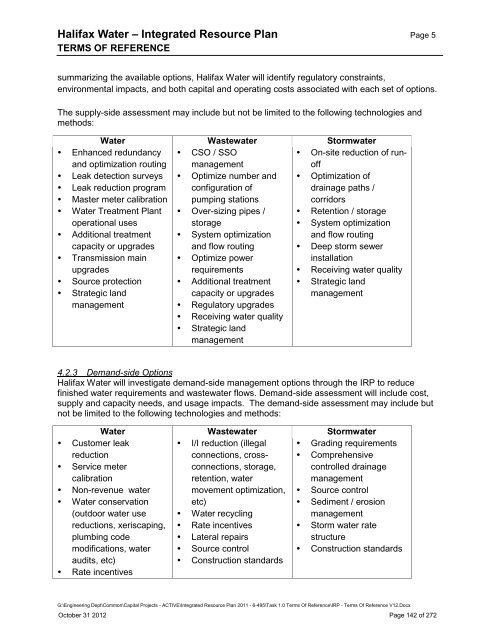volume 1 - Halifax Regional Municipality
volume 1 - Halifax Regional Municipality
volume 1 - Halifax Regional Municipality
You also want an ePaper? Increase the reach of your titles
YUMPU automatically turns print PDFs into web optimized ePapers that Google loves.
<strong>Halifax</strong> Water – Integrated Resource Plan Page 5<br />
TERMS OF REFERENCE<br />
summarizing the available options, <strong>Halifax</strong> Water will identify regulatory constraints,<br />
environmental impacts, and both capital and operating costs associated with each set of options.<br />
The supply-side assessment may include but not be limited to the following technologies and<br />
methods:<br />
Water Wastewater Stormwater<br />
• CSO / SSO<br />
management<br />
• Optimize number and<br />
configuration of<br />
pumping stations<br />
• Over-sizing pipes /<br />
storage<br />
• System optimization<br />
and flow routing<br />
• Optimize power<br />
requirements<br />
• Additional treatment<br />
capacity or upgrades<br />
• Regulatory upgrades<br />
• Receiving water quality<br />
• Strategic land<br />
management<br />
• Enhanced redundancy<br />
and optimization routing<br />
• Leak detection surveys<br />
• Leak reduction program<br />
• Master meter calibration<br />
• Water Treatment Plant<br />
operational uses<br />
• Additional treatment<br />
capacity or upgrades<br />
• Transmission main<br />
upgrades<br />
• Source protection<br />
• Strategic land<br />
management<br />
• On-site reduction of runoff<br />
• Optimization of<br />
drainage paths /<br />
corridors<br />
• Retention / storage<br />
• System optimization<br />
and flow routing<br />
• Deep storm sewer<br />
installation<br />
• Receiving water quality<br />
• Strategic land<br />
management<br />
4.2.3 Demand-side Options<br />
<strong>Halifax</strong> Water will investigate demand-side management options through the IRP to reduce<br />
finished water requirements and wastewater flows. Demand-side assessment will include cost,<br />
supply and capacity needs, and usage impacts. The demand-side assessment may include but<br />
not be limited to the following technologies and methods:<br />
Water Wastewater Stormwater<br />
• I/I reduction (illegal<br />
connections, crossconnections,<br />
storage,<br />
retention, water<br />
movement optimization,<br />
etc)<br />
• Water recycling<br />
• Rate incentives<br />
• Lateral repairs<br />
• Source control<br />
• Construction standards<br />
• Customer leak<br />
reduction<br />
• Service meter<br />
calibration<br />
• Non-revenue water<br />
• Water conservation<br />
(outdoor water use<br />
reductions, xeriscaping,<br />
plumbing code<br />
modifications, water<br />
audits, etc)<br />
• Rate incentives<br />
• Grading requirements<br />
• Comprehensive<br />
controlled drainage<br />
management<br />
• Source control<br />
• Sediment / erosion<br />
management<br />
• Storm water rate<br />
structure<br />
• Construction standards<br />
G:\Engineering Dept\Common\Capital Projects - ACTIVE\Integrated Resource Plan 2011 - 6-495\Task 1.0 Terms Of Reference\IRP - Terms Of Reference V12.Docx<br />
October 31 2012 Page 142 of 272
















